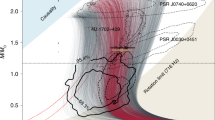Abstract
A possible model for the pulsar PSR J1852+0040 associated with the supernova remnant Kes 79 and detected in place of a central compact object in this remnant is discussed. The main observational properties of the pulsar can be understood as consequences of its weak surface magnetic field (B s < 3 × 1011 G) and short rotational period (P ∼ 0.1 s). Its X-ray emission is thermal, and is generated in a small region near the surface of the neutron star due to cooling of the surface as the surface accretes matter from a relict disk surrounding the pulsar. The radio emission is generated in the outer layers of the pulsar magnetosphere by the synchrotron (cyclotron) mechanism. The optical luminosity of J1852+0040 is estimated to be L opt < 1028 erg/s. If the spectral features in another central compact object, 1E 1207.4+5209, are interpreted as electron cyclotron lines, this provides evidence for a weak surface magnetic field for this neutron star as well (B < 6 × 1010 G). The hypothesis that all central compact objects have weak surface fields makes it possible to explain the number of detected central compact objects, the absence of pulsar-wind nebulae associated with these objects, and the fact that no pulsar has yet been detected at the position of SN 1987a. We suggest that, after the supernova remnant has dissipated, the central compact object becomes a weak X-ray source (XDINS), whose weak emission is also due to the weakness of its magnetic field.
Similar content being viewed by others
References
A. De Luca, AIP Conf. Proc. 983, 311 (2008).
E. V. Gotthelf, J. P. Halpern, and F. D. Seward, Astrophys. J. 627, 390 (2005).
S. B. Popov, M. E. Prokhorov, e-Print arXiv:astroph/0205298v1 (2002).
G. G. Pavlov, D. Sanwal, and M. A. Teter, ASP Conf. Ser. 271, 239 (2004).
E. V. Gotthelf and J. P. Halpern, e-Print arXiv:astroph/0711.1554v.1 (2007).
C. Y. Hui and W. Becker, Astron. Astrophys. 454, 543 (2006).
J. P. Halpern, E. V. Gotthelf, F. Camilo, and F. D. Seward, e-Print arXiv:astro-ph/0705.0978v1 (2007).
V. M. Malofeev, O. I. Malov, D. A. Teplykh, and A. P. Glushak, Astron. Telegr., No. 501, 1 (2005).
I. F. Malov, Radio Pulsars (Moscow, Nauka, 2004) [in Russian].
I. F. Malov, Pis’ma Astron. Zh. 29, 571 (2003) [Astron. Lett. 29, 502 (2003)].
V. M. Malofeev, I. F. Malov, O. I. Malov, and A. P. Glushak, Astron. Zh. 80, 449 (2003) [Astron. Rep. 47, 413 (2003)].
I. F. Malov and O. I. Malov, Astron. Zh. 83, 542 (2007) [Astron. Rep. 50, 483 (2007)].
V.M. Malofeev, (private commun., 2008).
V. M. Malofeev, Catalog of Pulsar Radio Spectra (PRAO, ONTI, Pushchino, 1999) [in Russian].
V. A. Izvekova, A. D. Kuz’min, V. M. Malofeev, and Yu. P. Shitov, Tr. Fiz. Inst. im. P.N. Lebedeva 199, 13 (1989).
M. D. Young, R. N. Manchester, and S. Johnston, Nature 400, 848 (1999).
A. Shearer, A. Golden, and G. Beskin, ASP Conf. Ser. 202, 307 (2000).
V. E. Zavlin, G. G. Pavlov, D. Sanwal, and J. Truemper, Astrophys. J. 540, L25 (2000).
D. Sanwal, G. P. Garmire, A. Garmire, et al., Bull. Amer. Astron. Soc. 34, 764 (2002).
S. Mereghetti, Astrophys. J. 581, 1280 (2002).
G. F. Bignami, P. A. Caraveo, A. De Luca, and S. Mereghetti, Nature 423, 725 (2003).
A. De Luca, S. Mereghetti, P. A. Caraveo, et al., Astron. Astrophys. 418, 625 (2004).
Y. Ogelman and M. A. Alpar, Astrophys. J. 603, L33 (2004).
R. N. Mabchester, AIP Conf. Proc. 937, 134 (2007).
J. G. Kirk, Y. Lguborsky, and J. Petri, e-Print arXiv:astro-ph/0703116v2 (2007).
R. N. Manchester, G. B. Hobbs, A. Teoh, and M. Hobbs, Astron. J. 129, 1993 (2005).
C.-A. Faucher-Giguerre and V.M. Kaspi, Astrophys. J. 643, 332 (2006).
I. F. Malov, Astron. Zh. 84, 531 (2007) [Astron. Rep. 51, 477 (2007)].
I. F. Malov, Pis’ma v Astron. Zh. 34, 711 (2008) [Astron. Lett. 34, 699 (2008)].
I. F. Malov, Astron. Zh. 78, 452 (2001) [Astron. Rep. 45, 389 (2001)].
Author information
Authors and Affiliations
Additional information
Original Russian Text © I.F. Malov, 2009, published in Astronomicheskiĭ Zhurnal, 2009, Vol. 86, No. 5, pp. 512–517.
Rights and permissions
About this article
Cite this article
Malov, I.F. The pulsar J1852+0040 in Kes 79 and the nature of central compact objects in supernova remnants. Astron. Rep. 53, 472–476 (2009). https://doi.org/10.1134/S1063772909050114
Received:
Accepted:
Published:
Issue Date:
DOI: https://doi.org/10.1134/S1063772909050114




